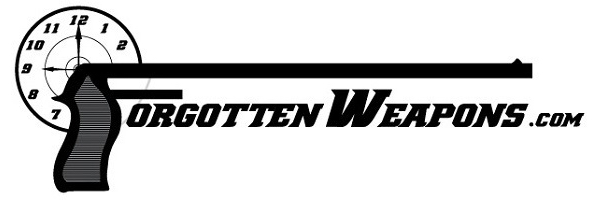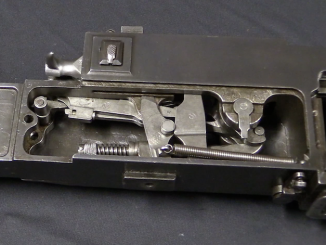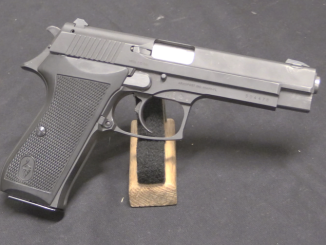The Beretta Model 34 was basically the final iteration of a design by Tullio Marengoni that began all the way back in 1915. That pistol was updated in the early 1920s, and that one was updated in 1931. The Model 1931 was converted to .380 ACP (aka 9mm Short) as the Model 1932, which became the Model 1934 with the addition of a hammer half-cock notch and steel grip panel backing. Police and military contract began in 1935, with the Italian Army formally adopting it in 1936 and purchasing nearly 400,000 of them by 1940. It would ultimately see service will basically all the armed elements of the Italian military and civil security services as well as foreign nations including Germany, Romania, and Finland. As a souvenir for British or American troops, the Model 1934 was also a prized piece.
Essentially, the Model 1934 is compact, simple, durable, and reliable. It is an excellent military pistol; easy to carry unobtrusively but dependable when called upon. After World War Two it stayed in production until 1980, despite introduction of many other more modern options by Beretta. Today a bunch of the pistols have become available on the US collector’s market. Thanks to Royal Tiger Imports for sending this example for me to film!
Beretta Model 1934 serial numbers and dates (source: “1915-1985 Settant’ Anni di Pistole Beretta”):
1934 – 1942 – from about 500073 to 999996
1934 – 1942 – from 1 to about 40000
1943 – 1945 – from F00001 to F99997
1943 – 1945 – from G00001 to G57486
1943 – 1945 – from 0001AA to 9997AA
1943 – 1945 – from 0001BB to 9971BB
1946 – 1949 – from C00001 to C99998
1949 – 1954 – from D00001 to D99999
1954 – 1967 – from E00001 to E95760
1967 – 1973 – from F50001 to F61693
1970 – 1975 – from G00007 to G49620
1972 – 1974 – from H00001 to H25000
1971 – 1980 – from T 1 to T 10217
Other pistols in the Beretta development series:
Modle 1915: https://youtu.be/yVvPOiHGh7o
Model 1923: https://youtu.be/XIIAfAS3nXM
Model 1931: https://youtu.be/1b7KtnA8O_Q
Trials Model 1934: https://youtu.be/SQTIBqTRxIE




– Josserand & Stevenson, Pistols, Revolvers, and Ammunition, New York; Bonanza books 1972, p.231.
Beretta must have agreed. The Beretta Model 70 in both 7.65mm and 9mm Corto is essentially the 1934 with a better-shaped frame and grip;
https://upload.wikimedia.org/wikipedia/commons/c/c4/Beretta_70_7.65.jpg
And the later Beretta Model 84 is essentially a Model 70 with a Walther-type double-action;
https://www.thearmorylife.com/forum/attachments/20220901_144624-jpg.30338/
Note that the 84 sensibly has an ambidextrous 1911-type thumb safety setup instead of the reprehensible Walther-type “hammer-dropper”.
clear ether
eon
All of them suffer from the key thing that really soured me on the M9: The open-top slide, which should more accurately be termed “the hand-eater”.
I’ve still got scars from doing clearance drills on the M9. Up until I had to deal with actually using that pistol, I was indifferent to the open-top slide and I thought it looked cool and stylish.
Couple of iterations of enthusiastic “tap-rack-bang” drills, and you begin to notice the downsides, like “Gee, my hand it is seriously chewed up from that damn thing… I never had that issue with any of my other semi-auto handguns…”
Color me in as “Not a fan” for the classic Beretta design cues. The Browning BDA was a better overall .380 pistol from Beretta. Closed slides, all the way, says I.
Also much sturdier. Even the blowback Berettas and the various near-copies from other makers had problems with slide cracking, due to the stress of the slide’s movement.
The FN BDA 380, which was basically a Model 84 with a fully-closed slide, was a much better proposition, even with that idiotic Walther “hammer dropper”.
It’s interesting to note that when Llama created the M82 for the Spanish army, that M92 “clone” had a fully-enclosed slide.
https://www.youtube.com/watch?v=Na2bgWFrKVA
No fools they.
clear ether
eon
I think one of the things that sort of soured me on Beretta as a company was an interview I saw with some of the executives and engineers. In it, they were talking about how they felt that “styling” was a key point, and brought up the open-top slide as a “distinctively Beretta design element” that they had deliberately perpetuated down the years…
My take on that was that if you’re biasing your designs towards a specific “look”, ignoring very real engineering and ergonomic issues, I will not be buying your products. Ever.
Wasn’t long after that I was selling off my Beretta pistols, and transitioning to Glock, who apparently didn’t give a rat’s shiny rectum about “styling”…
I only ever owned one Beretta, the M92FS version of the M9.
It broke the trigger return spring on me, fortunately on the range. I got a replacement spring from Beretta USA (free) and installed it myself.
Then I sold the thing. I only ever give a weapon one chance to f**k up on me, then it’s history.
Yes, I went back to the 1911.
clear ether
eon
The Walther tilting lock had been chosen over the Browning tilting barrel for the M1951 because it was more compatible with the open slide construction.
However, given the track record of the various 92 models it’s hard to say it had been the wrong choice also from a purely engineering point of view.
“For an aircraft to fly well, it must be beautiful” (Marcel Dassault).
“(…)“For an aircraft to fly well, it must be beautiful” (Marcel Dassault).(…)”
Maybe, but https://www.aerotime.aero/articles/31007-pl-12-airtruk-australias-strangest-aircraft
“(…)934 from being perhaps the best all-around .380 auto(…)1972(…)”
Observe that whilst Modello 934 did certainly meet 1930s requirements, it was Single Action and in 1971 that would make it lacking in this regard when compared to FEG AP-63 or HK-4.
Hence the Model 84. Of course eight years later the Glock came along and made “traditional” double-action on a self-loader a questionable choice… with a trigger action that dated to 1908 (in the Roth-Sauer).
Walther did not create the “conventional” double-action lockwork for auto pistols, BTW. It was apparently the work of Alois Tomiska in Czechoslovakia, whose “Little Tom” .25 ACP double-action pistol debuted in 1906.
One of Walther’s early competitors was August Menz, whose Menz “Spezial Modell” 7.65mm in 1930 was essentially a PPK with a safety that locked the hammer, rather than “dropping” it.
cheers
eon
The P-47 refutes the notion that a kick-a** airplane needs to be beautiful. For that matter the Me-262 looked like a pregnant porpoise
Details, details. Please note that that “out of battery safety” doubles as disconnector.
I’ll pay extra money for a new barrel, maybe shoot straighter?
Marengoni may have been a genius but you will see he was foreshadowed by the Spaniards if you look at the 1908 and 1911 “Victoria” pistols, forerunners to the Ruby. Always touted as a “simplified Browning 1903,” the features that the Victoria and Ruby share with the 1915 Beretta et fils include: Recoil spring and guide rod hold the safety in place, location and operation of safety, disconnector combined with out-of-battery safety impinges both slide and trigger bar in the same location (though are separate pieces on the Spaniards), location of magazine catch and main hammer spring, and themagazine catch is powered by the same hammer spring and strut. You might add the original caliber of 7.65 to the list. The Ruby is actually so clever that many features wound up in subsequent designs from other manufacturers.
I’m pretty sure the first Beretta 1915 was in 9mm Glisenti. Only in 1917 they were made in .32 ACP, thus retaining the name (but losing the almost useless rear safety).
I like the 1934, it is a sturdy little gun. My main objection to it is the safety. Where it is located makes it almost impossible to operate with the thumb of the right hand. The alternative is to use the half cock notch, which seemed quite satisfactory in operation.
okay, I think a range report or competition video is needed here.
“I like the Beretta, and regard it as by far the best standard autoloading pocket pistol, or small size arm, in the world. The Walther PP is unbeatable because of its double-action, but the rugged Beretta’s toughness keeps it in the running when pistol comparisons start.” J. N. George,Ordnance Went Up Front
Just good to see posts back on the site instead of only on *-tube. The comments here are from the true disciples of GJ. I thank you all for adding to my knowledge and geekery.
OOPS, that’s Dunlap’s book, not George’s.
I have had both a 1934 and 1935, in .380 and .32. I had no problems shooting them; they did not eat my hand. And no, my hands are not small. Recoil did not bother me.
I have the jacket with same italian post-ww2 camo, but mine has comically big and unflexible elbow pads, like 20×20 cms!
It’s interesting to note that’s the post war version (slightly more reddish colors) of the first camo pattern ever issued to troops, the M29 “Telo Mimetico”.
It had been in service until the early ’80s.
Early ’90s, sorry.
Informative as always thanks Ian.
To see Italian WW2 weapons in the North African desert warfare context I recommend the movie “Giarabub”, contemporaneous with the events (released in 1942) and shot for a good part in Libia. Here is a link: https://www.youtube.com/watch?v=DtGWtcZvPMk
You can read about the siege of the Giarabub oasis in the internet
Is there a way to rethread the damaged threads on the barrel of my Beretta 1934?
I can tell you one thing that does not work. The barrel is 0.55″ or 14 mm in diameter. A 1/2-20 die will not fit the threads. This is contrary to some reports on the Internet saying the barrel thread is 1/2-20. I found this out the hard way by investing $6 in a die before I brought the gun home.
The thread might be M14-1.25. I tried a M14-1.5 gauge and it was too coarse.